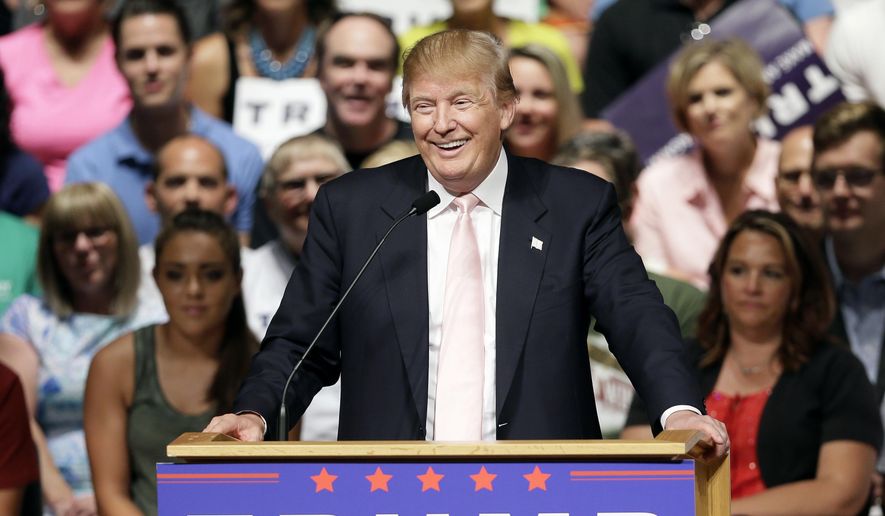OPINION:
The upcoming Republican debate promises to be the political Super Bowl thanks to three factors: Brand Trump; a cast of political candidates trying to separate themselves from each other; and the Republican Party.
With these three entities in play, how do Donald Trump (an entertainer brand), 10 on-stage candidates (individual personal political brands), and the Republican Party (corporate brand) satisfy the needs of their respective constituencies and score points with voters?
Pundits love to use the term brand without really understanding its true marketing meaning; for them, a brand is merely a name or identifier. But this misses an important point: how do voters (customers) perceive the name or brand under discussion?
Using this branding model, Mr. Trump can best be described as the outlier. He is only a political brand because he has deemed it so, but from a pure marketing perspective, he is nothing more than an entertainer providing voters red meat sound bites that they want to hear, thereby giving him strength in the polls. His strength—he is not a political brand—is also his weakness. The goal for the other candidates is to find an issue that connects with the voters and then outplays Mr. Trump’s current voter popularity.
The electorate wants “problem solvers” and, at first look, Trump provides “quick and easy” solutions to issues where politicians have failed to deliver. To say the Republican voters are fed up is an understatement. Voters understand what Mr. Trump says because he says what some people think and are afraid to say. He doesn’t use facts but rather emotion to create a buzz wherever he speaks, The issue the other debaters is to differentiate themselves from Mr. Trump, the nonpolitical type, and then separate themselves from the others on the stage.
Getting attention is the first rule of promotion, a marketing fundamental. Trump has done this brilliantly. However, keeping this high level of interest is not easy. Sound-bites don’t a policy make, and when the facts and figures are presented and voters see flaws in his “standup routine,” the long-term strength of the Brand Trump could be in question.
A good strategy for the nine other debaters would be to come prepared with data and a plan on how to deal with a specific issue, like border security. The model to use is the 1993 Gore–Perot NAFTA debate in which Mr. Gore decimated Mr. Perot’s arguments against the treaty with data that the populist Perot brand could not process. Yes, the political brand of Al Gore with his facts and figures overwhelmed the rather affable Perot brand. The result? Mr. Perot never recovered, and the treaty passed.
(The jury is still out on whether it was a good treaty.)
Another important variable within branding strategy is sincerity or consistency. Here, Mr. Trump has some issues. Over the years, he has been on both sides of numerous issues, from immigration to health care. For example, he once wrote: “The majority of legal immigrants can often make significant contributions to our society because they have special skills and because they add to our nation’s cultural diversity. They come with the best of intentions.” (The America We Deserve, by Donald Trump, 2000). On health care he said: “I’m a conservative on most issues but a liberal on health The America We Deserve). This is more than enough “red meat” for any political brand to score some important points.
The other candidates must somehow connect with voters by labeling Mr. Trump as a rather successful businessman but not the best political leader. Politics is not business and political behavior entails skills that Mr. Trump may not possess. In business, the CEO doesn’t need to persuade; in politics, it’s all about getting results through persuasion.
The important point that all these political brands should make at the debate is that they are proud to be in politics, and that real solutions come only with real strategies and “political know-how.” Just ask President Bill Clinton and Speaker Newt Gingrich how to make things happen politically.
Jeb Bush is the one candidate with the most to lose if he doesn’t stand up to Trump. His brand perception as the reasonable Republican candidate, the competent executive who gets along and gets things done could score big points if he respectfully challenges Brand Trump. Using his strong brand attributes, Bush, could forcefully disagree with Mr. Trump, the entertainer, and if done precisely, appeal to those angry voters who want to see someone take a stand against something, even if it is Mr. Trump who has to be sacrificed.
The Republican brand, another entity in play, is much like General Motors (GM) from a branding perspective. Both have a portfolio (candidates/products) from which customers/voters can select. Their role is to satisfy the needs of present and future interested parties. What is essential to remember in this discussion is that people buy brands, not companies. This translates into customers not buying a corporate brand but rather making a buying decision based on an individual brand name strategy, e.g., buying a Chevy, not a GM-made, product.
When all is said, once the Republican nominee is selected, the question will be whether his or her individual brand can appeal to independents.
Branding can be an effective strategy in winning primaries and elections. President Barack Obama was able to brand himself into the White House. If Mr. Trump, the other candidates, and the Republicans can put together a brand perception that we in marketing call “position,” then success can be achieved. But there’s one caveat: it’s the voter’s needs that are important, not the candidates. And oh yes, it is always easier when you have branding and marketing in mind.
John Tantillo is branding editor for Fridge Magazine, the magazine for small business owners and entrepreneurs and is the author of “People Buy Brands, Not Companies.”




Please read our comment policy before commenting.